Tender and Contract Management for Construction of a Large Thermal Solar Power Plant in NSW
VerifiedAdded on 2023/06/11
|15
|4198
|493
AI Summary
This paper describes a large complex project involving the construction of a solar-thermal power plant in Victoria, Australia. It discusses various aspects of the AS 4120-1994 in the context of the project tendering process, contract management, quality management, safety, and dispute resolution, as well as the procedure for inviting the tenderers, tender evaluation, and award of tender after a through tender negotiation.
Contribute Materials
Your contribution can guide someone’s learning journey. Share your
documents today.
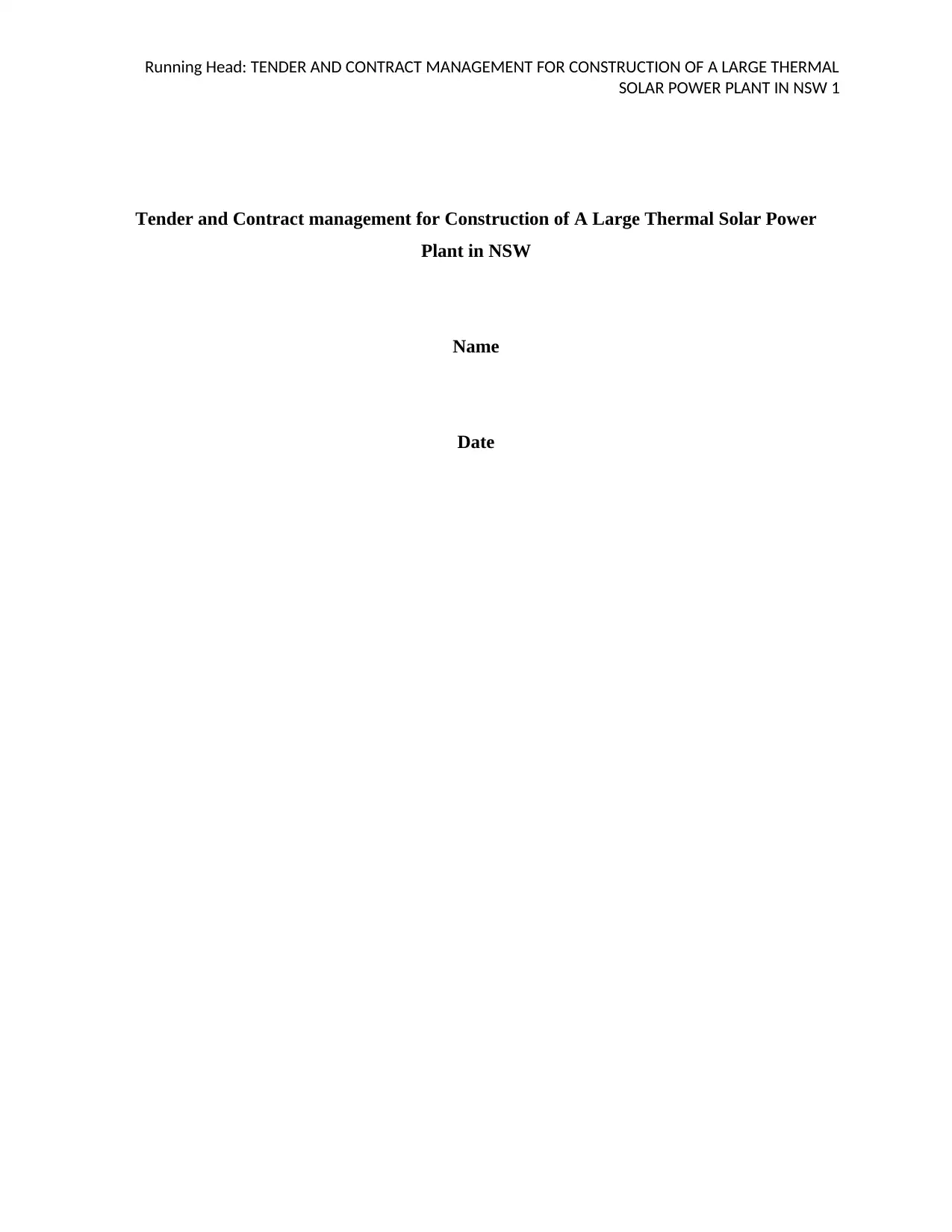
Running Head: TENDER AND CONTRACT MANAGEMENT FOR CONSTRUCTION OF A LARGE THERMAL
SOLAR POWER PLANT IN NSW 1
Tender and Contract management for Construction of A Large Thermal Solar Power
Plant in NSW
Name
Date
SOLAR POWER PLANT IN NSW 1
Tender and Contract management for Construction of A Large Thermal Solar Power
Plant in NSW
Name
Date
Secure Best Marks with AI Grader
Need help grading? Try our AI Grader for instant feedback on your assignments.
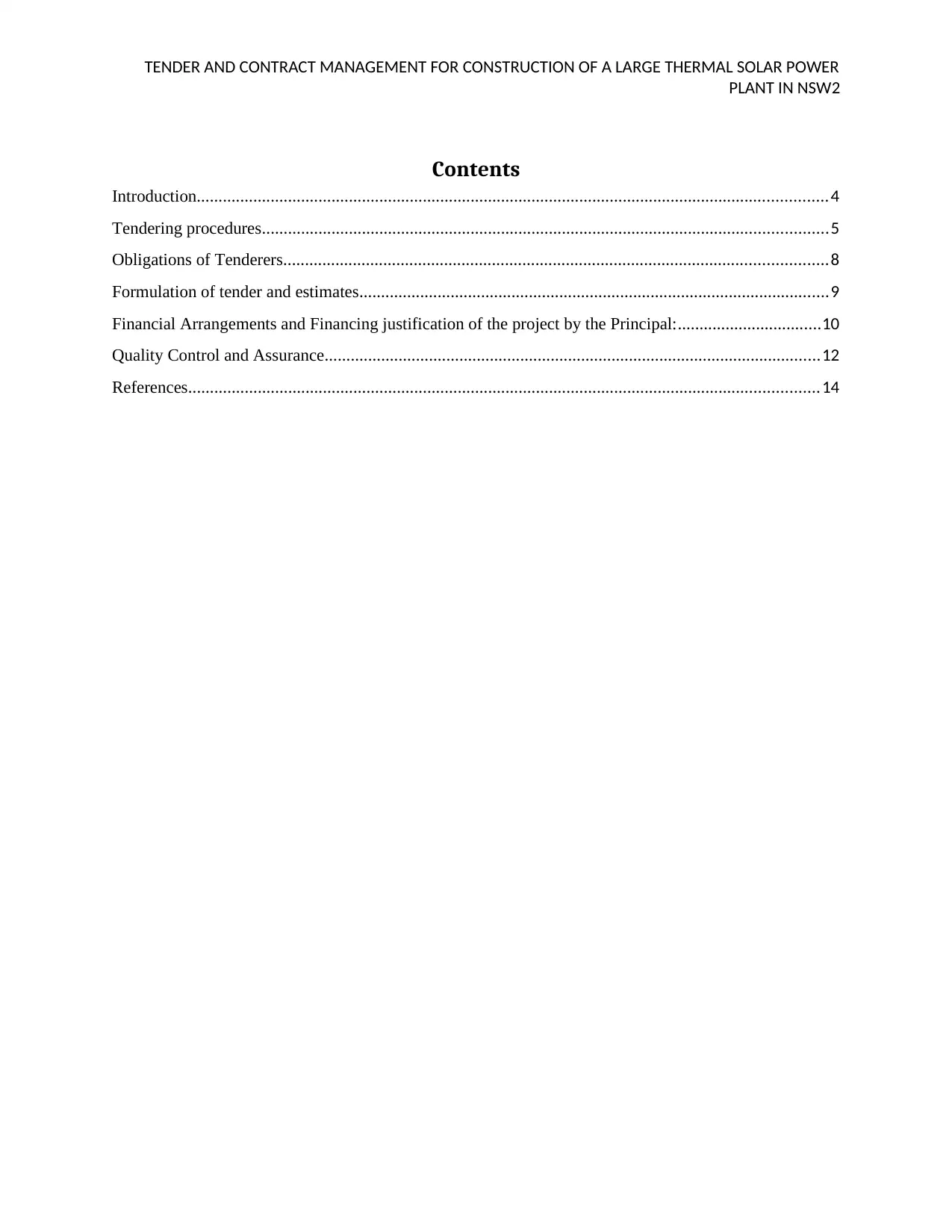
TENDER AND CONTRACT MANAGEMENT FOR CONSTRUCTION OF A LARGE THERMAL SOLAR POWER
PLANT IN NSW2
Contents
Introduction.................................................................................................................................................4
Tendering procedures..................................................................................................................................5
Obligations of Tenderers.............................................................................................................................8
Formulation of tender and estimates............................................................................................................9
Financial Arrangements and Financing justification of the project by the Principal:.................................10
Quality Control and Assurance..................................................................................................................12
References.................................................................................................................................................14
PLANT IN NSW2
Contents
Introduction.................................................................................................................................................4
Tendering procedures..................................................................................................................................5
Obligations of Tenderers.............................................................................................................................8
Formulation of tender and estimates............................................................................................................9
Financial Arrangements and Financing justification of the project by the Principal:.................................10
Quality Control and Assurance..................................................................................................................12
References.................................................................................................................................................14
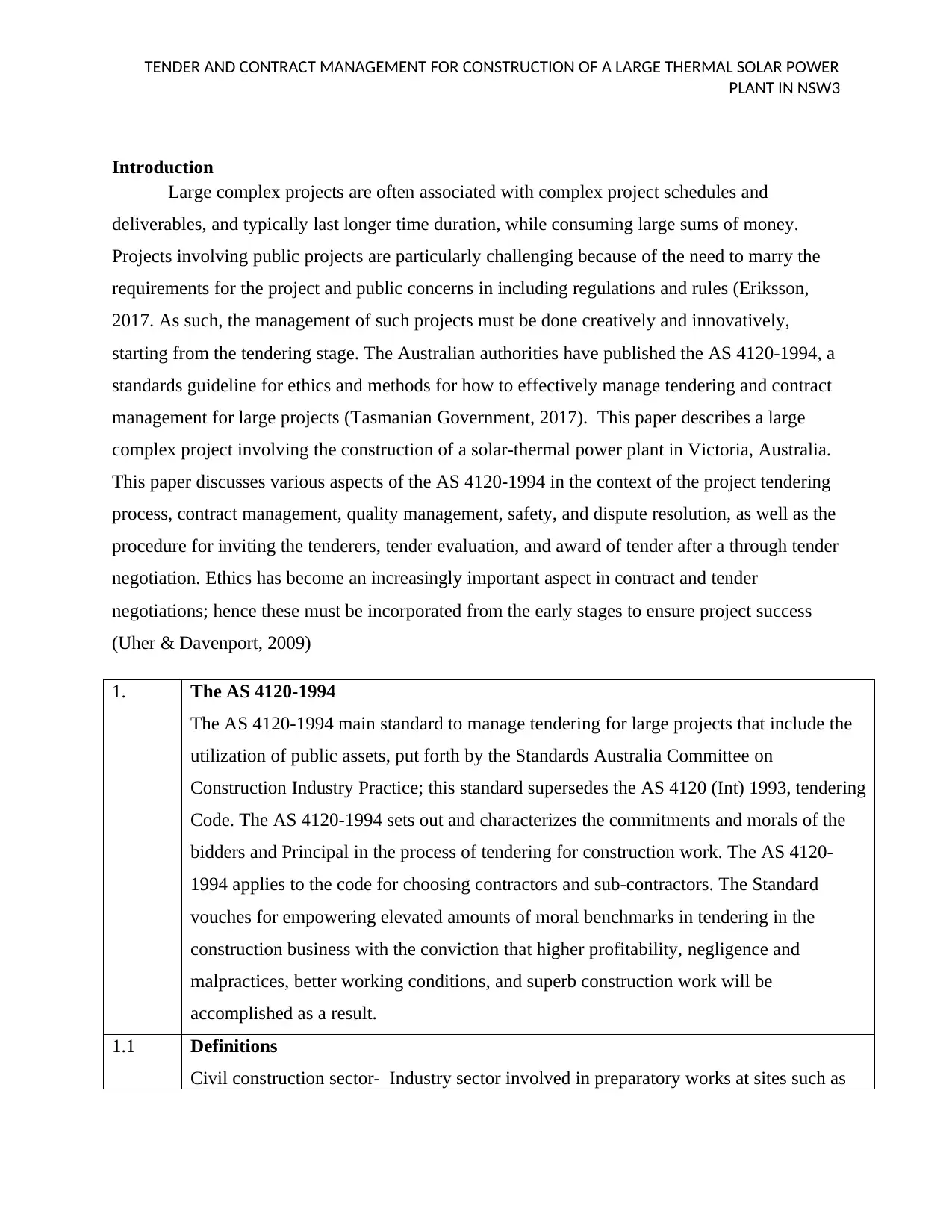
TENDER AND CONTRACT MANAGEMENT FOR CONSTRUCTION OF A LARGE THERMAL SOLAR POWER
PLANT IN NSW3
Introduction
Large complex projects are often associated with complex project schedules and
deliverables, and typically last longer time duration, while consuming large sums of money.
Projects involving public projects are particularly challenging because of the need to marry the
requirements for the project and public concerns in including regulations and rules (Eriksson,
2017. As such, the management of such projects must be done creatively and innovatively,
starting from the tendering stage. The Australian authorities have published the AS 4120-1994, a
standards guideline for ethics and methods for how to effectively manage tendering and contract
management for large projects (Tasmanian Government, 2017). This paper describes a large
complex project involving the construction of a solar-thermal power plant in Victoria, Australia.
This paper discusses various aspects of the AS 4120-1994 in the context of the project tendering
process, contract management, quality management, safety, and dispute resolution, as well as the
procedure for inviting the tenderers, tender evaluation, and award of tender after a through tender
negotiation. Ethics has become an increasingly important aspect in contract and tender
negotiations; hence these must be incorporated from the early stages to ensure project success
(Uher & Davenport, 2009)
1. The AS 4120-1994
The AS 4120-1994 main standard to manage tendering for large projects that include the
utilization of public assets, put forth by the Standards Australia Committee on
Construction Industry Practice; this standard supersedes the AS 4120 (Int) 1993, tendering
Code. The AS 4120-1994 sets out and characterizes the commitments and morals of the
bidders and Principal in the process of tendering for construction work. The AS 4120-
1994 applies to the code for choosing contractors and sub-contractors. The Standard
vouches for empowering elevated amounts of moral benchmarks in tendering in the
construction business with the conviction that higher profitability, negligence and
malpractices, better working conditions, and superb construction work will be
accomplished as a result.
1.1 Definitions
Civil construction sector- Industry sector involved in preparatory works at sites such as
PLANT IN NSW3
Introduction
Large complex projects are often associated with complex project schedules and
deliverables, and typically last longer time duration, while consuming large sums of money.
Projects involving public projects are particularly challenging because of the need to marry the
requirements for the project and public concerns in including regulations and rules (Eriksson,
2017. As such, the management of such projects must be done creatively and innovatively,
starting from the tendering stage. The Australian authorities have published the AS 4120-1994, a
standards guideline for ethics and methods for how to effectively manage tendering and contract
management for large projects (Tasmanian Government, 2017). This paper describes a large
complex project involving the construction of a solar-thermal power plant in Victoria, Australia.
This paper discusses various aspects of the AS 4120-1994 in the context of the project tendering
process, contract management, quality management, safety, and dispute resolution, as well as the
procedure for inviting the tenderers, tender evaluation, and award of tender after a through tender
negotiation. Ethics has become an increasingly important aspect in contract and tender
negotiations; hence these must be incorporated from the early stages to ensure project success
(Uher & Davenport, 2009)
1. The AS 4120-1994
The AS 4120-1994 main standard to manage tendering for large projects that include the
utilization of public assets, put forth by the Standards Australia Committee on
Construction Industry Practice; this standard supersedes the AS 4120 (Int) 1993, tendering
Code. The AS 4120-1994 sets out and characterizes the commitments and morals of the
bidders and Principal in the process of tendering for construction work. The AS 4120-
1994 applies to the code for choosing contractors and sub-contractors. The Standard
vouches for empowering elevated amounts of moral benchmarks in tendering in the
construction business with the conviction that higher profitability, negligence and
malpractices, better working conditions, and superb construction work will be
accomplished as a result.
1.1 Definitions
Civil construction sector- Industry sector involved in preparatory works at sites such as
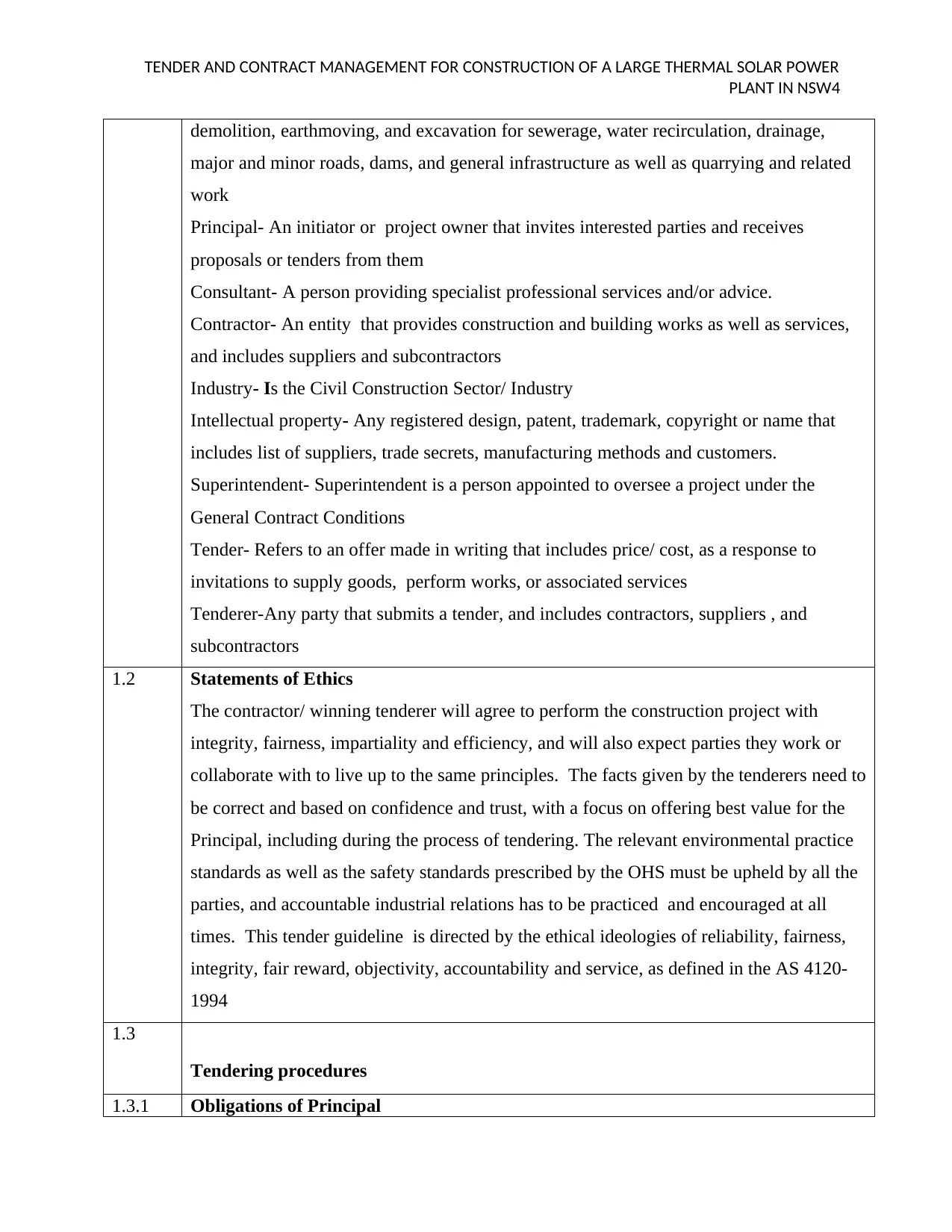
TENDER AND CONTRACT MANAGEMENT FOR CONSTRUCTION OF A LARGE THERMAL SOLAR POWER
PLANT IN NSW4
demolition, earthmoving, and excavation for sewerage, water recirculation, drainage,
major and minor roads, dams, and general infrastructure as well as quarrying and related
work
Principal- An initiator or project owner that invites interested parties and receives
proposals or tenders from them
Consultant- A person providing specialist professional services and/or advice.
Contractor- An entity that provides construction and building works as well as services,
and includes suppliers and subcontractors
Industry- Is the Civil Construction Sector/ Industry
Intellectual property- Any registered design, patent, trademark, copyright or name that
includes list of suppliers, trade secrets, manufacturing methods and customers.
Superintendent- Superintendent is a person appointed to oversee a project under the
General Contract Conditions
Tender- Refers to an offer made in writing that includes price/ cost, as a response to
invitations to supply goods, perform works, or associated services
Tenderer-Any party that submits a tender, and includes contractors, suppliers , and
subcontractors
1.2 Statements of Ethics
The contractor/ winning tenderer will agree to perform the construction project with
integrity, fairness, impartiality and efficiency, and will also expect parties they work or
collaborate with to live up to the same principles. The facts given by the tenderers need to
be correct and based on confidence and trust, with a focus on offering best value for the
Principal, including during the process of tendering. The relevant environmental practice
standards as well as the safety standards prescribed by the OHS must be upheld by all the
parties, and accountable industrial relations has to be practiced and encouraged at all
times. This tender guideline is directed by the ethical ideologies of reliability, fairness,
integrity, fair reward, objectivity, accountability and service, as defined in the AS 4120-
1994
1.3
Tendering procedures
1.3.1 Obligations of Principal
PLANT IN NSW4
demolition, earthmoving, and excavation for sewerage, water recirculation, drainage,
major and minor roads, dams, and general infrastructure as well as quarrying and related
work
Principal- An initiator or project owner that invites interested parties and receives
proposals or tenders from them
Consultant- A person providing specialist professional services and/or advice.
Contractor- An entity that provides construction and building works as well as services,
and includes suppliers and subcontractors
Industry- Is the Civil Construction Sector/ Industry
Intellectual property- Any registered design, patent, trademark, copyright or name that
includes list of suppliers, trade secrets, manufacturing methods and customers.
Superintendent- Superintendent is a person appointed to oversee a project under the
General Contract Conditions
Tender- Refers to an offer made in writing that includes price/ cost, as a response to
invitations to supply goods, perform works, or associated services
Tenderer-Any party that submits a tender, and includes contractors, suppliers , and
subcontractors
1.2 Statements of Ethics
The contractor/ winning tenderer will agree to perform the construction project with
integrity, fairness, impartiality and efficiency, and will also expect parties they work or
collaborate with to live up to the same principles. The facts given by the tenderers need to
be correct and based on confidence and trust, with a focus on offering best value for the
Principal, including during the process of tendering. The relevant environmental practice
standards as well as the safety standards prescribed by the OHS must be upheld by all the
parties, and accountable industrial relations has to be practiced and encouraged at all
times. This tender guideline is directed by the ethical ideologies of reliability, fairness,
integrity, fair reward, objectivity, accountability and service, as defined in the AS 4120-
1994
1.3
Tendering procedures
1.3.1 Obligations of Principal
Secure Best Marks with AI Grader
Need help grading? Try our AI Grader for instant feedback on your assignments.
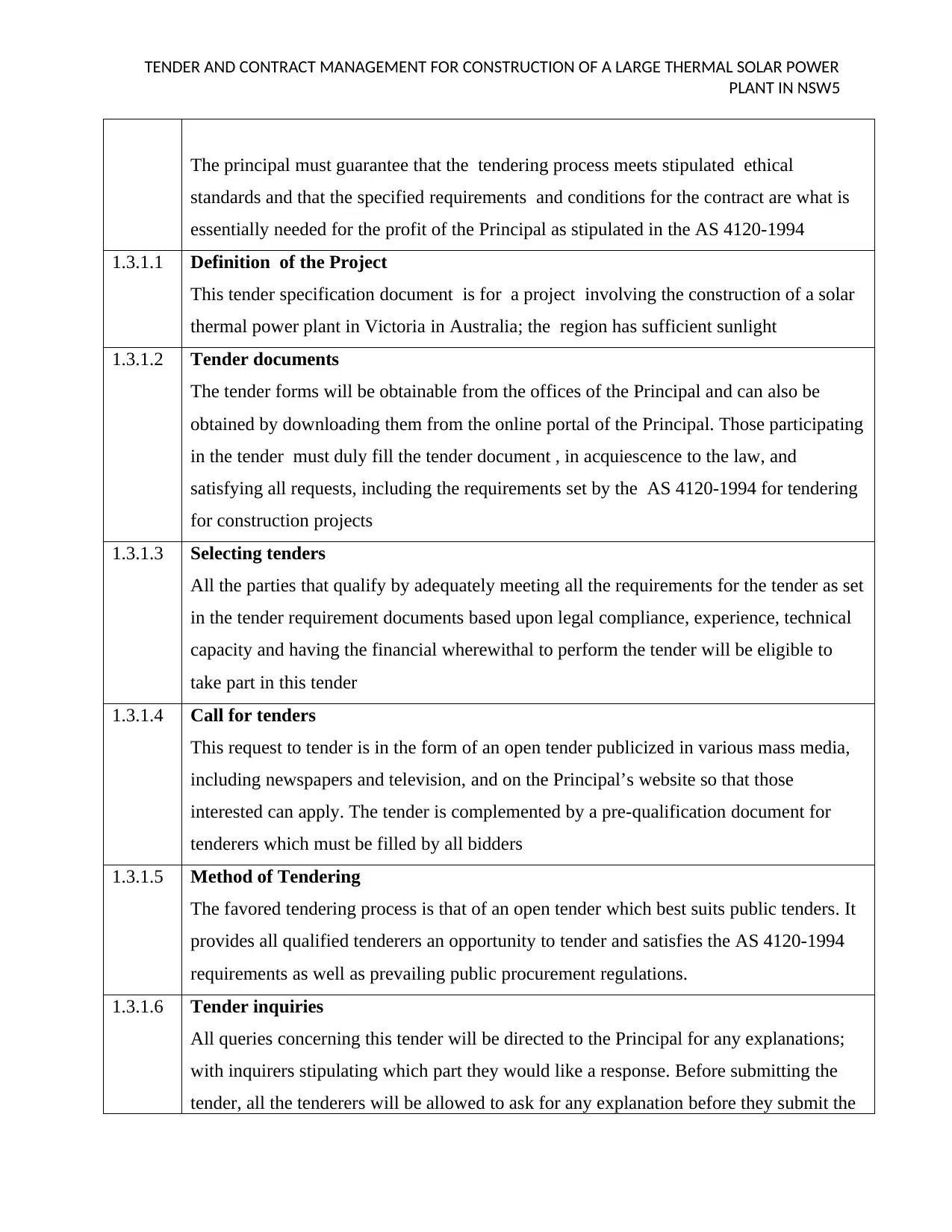
TENDER AND CONTRACT MANAGEMENT FOR CONSTRUCTION OF A LARGE THERMAL SOLAR POWER
PLANT IN NSW5
The principal must guarantee that the tendering process meets stipulated ethical
standards and that the specified requirements and conditions for the contract are what is
essentially needed for the profit of the Principal as stipulated in the AS 4120-1994
1.3.1.1 Definition of the Project
This tender specification document is for a project involving the construction of a solar
thermal power plant in Victoria in Australia; the region has sufficient sunlight
1.3.1.2 Tender documents
The tender forms will be obtainable from the offices of the Principal and can also be
obtained by downloading them from the online portal of the Principal. Those participating
in the tender must duly fill the tender document , in acquiescence to the law, and
satisfying all requests, including the requirements set by the AS 4120-1994 for tendering
for construction projects
1.3.1.3 Selecting tenders
All the parties that qualify by adequately meeting all the requirements for the tender as set
in the tender requirement documents based upon legal compliance, experience, technical
capacity and having the financial wherewithal to perform the tender will be eligible to
take part in this tender
1.3.1.4 Call for tenders
This request to tender is in the form of an open tender publicized in various mass media,
including newspapers and television, and on the Principal’s website so that those
interested can apply. The tender is complemented by a pre-qualification document for
tenderers which must be filled by all bidders
1.3.1.5 Method of Tendering
The favored tendering process is that of an open tender which best suits public tenders. It
provides all qualified tenderers an opportunity to tender and satisfies the AS 4120-1994
requirements as well as prevailing public procurement regulations.
1.3.1.6 Tender inquiries
All queries concerning this tender will be directed to the Principal for any explanations;
with inquirers stipulating which part they would like a response. Before submitting the
tender, all the tenderers will be allowed to ask for any explanation before they submit the
PLANT IN NSW5
The principal must guarantee that the tendering process meets stipulated ethical
standards and that the specified requirements and conditions for the contract are what is
essentially needed for the profit of the Principal as stipulated in the AS 4120-1994
1.3.1.1 Definition of the Project
This tender specification document is for a project involving the construction of a solar
thermal power plant in Victoria in Australia; the region has sufficient sunlight
1.3.1.2 Tender documents
The tender forms will be obtainable from the offices of the Principal and can also be
obtained by downloading them from the online portal of the Principal. Those participating
in the tender must duly fill the tender document , in acquiescence to the law, and
satisfying all requests, including the requirements set by the AS 4120-1994 for tendering
for construction projects
1.3.1.3 Selecting tenders
All the parties that qualify by adequately meeting all the requirements for the tender as set
in the tender requirement documents based upon legal compliance, experience, technical
capacity and having the financial wherewithal to perform the tender will be eligible to
take part in this tender
1.3.1.4 Call for tenders
This request to tender is in the form of an open tender publicized in various mass media,
including newspapers and television, and on the Principal’s website so that those
interested can apply. The tender is complemented by a pre-qualification document for
tenderers which must be filled by all bidders
1.3.1.5 Method of Tendering
The favored tendering process is that of an open tender which best suits public tenders. It
provides all qualified tenderers an opportunity to tender and satisfies the AS 4120-1994
requirements as well as prevailing public procurement regulations.
1.3.1.6 Tender inquiries
All queries concerning this tender will be directed to the Principal for any explanations;
with inquirers stipulating which part they would like a response. Before submitting the
tender, all the tenderers will be allowed to ask for any explanation before they submit the
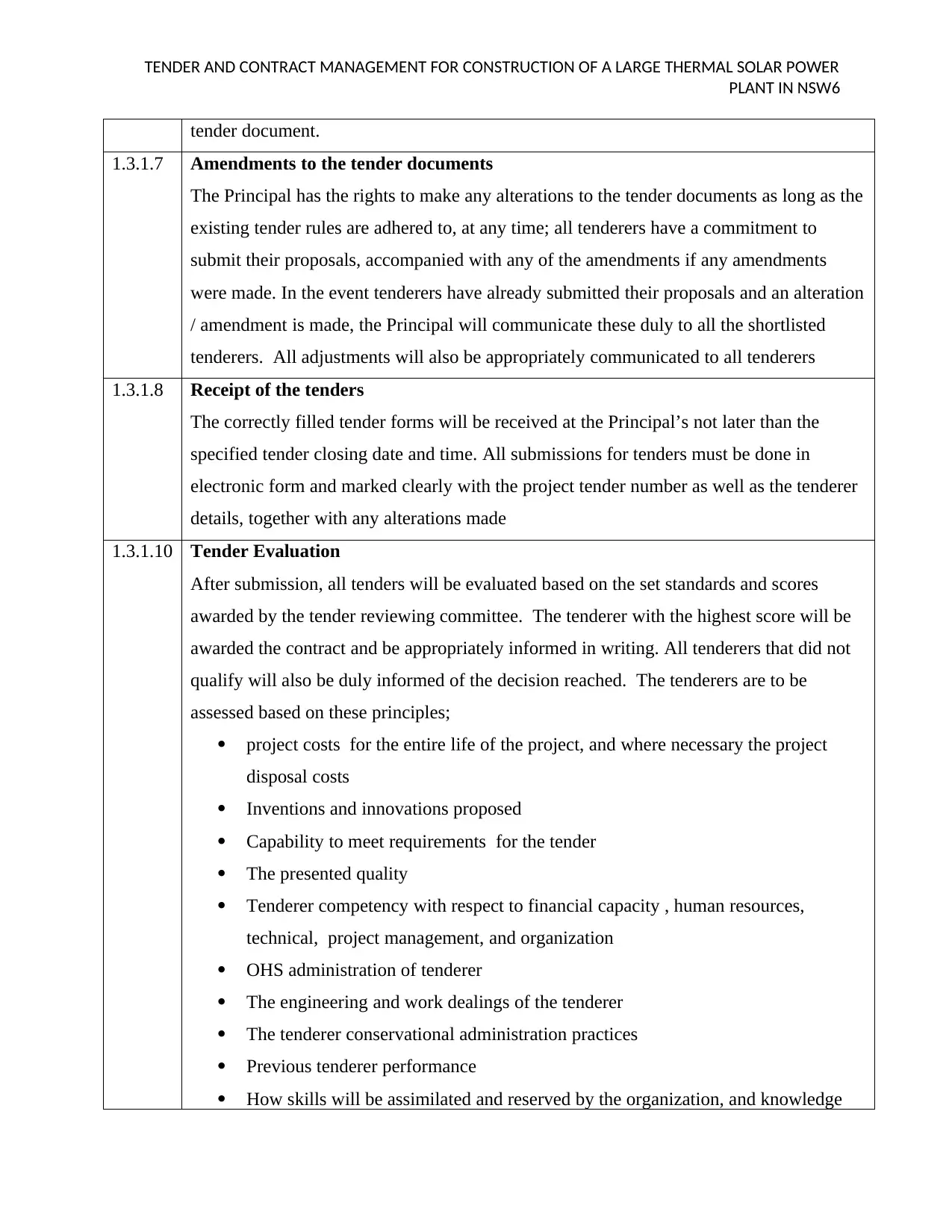
TENDER AND CONTRACT MANAGEMENT FOR CONSTRUCTION OF A LARGE THERMAL SOLAR POWER
PLANT IN NSW6
tender document.
1.3.1.7 Amendments to the tender documents
The Principal has the rights to make any alterations to the tender documents as long as the
existing tender rules are adhered to, at any time; all tenderers have a commitment to
submit their proposals, accompanied with any of the amendments if any amendments
were made. In the event tenderers have already submitted their proposals and an alteration
/ amendment is made, the Principal will communicate these duly to all the shortlisted
tenderers. All adjustments will also be appropriately communicated to all tenderers
1.3.1.8 Receipt of the tenders
The correctly filled tender forms will be received at the Principal’s not later than the
specified tender closing date and time. All submissions for tenders must be done in
electronic form and marked clearly with the project tender number as well as the tenderer
details, together with any alterations made
1.3.1.10 Tender Evaluation
After submission, all tenders will be evaluated based on the set standards and scores
awarded by the tender reviewing committee. The tenderer with the highest score will be
awarded the contract and be appropriately informed in writing. All tenderers that did not
qualify will also be duly informed of the decision reached. The tenderers are to be
assessed based on these principles;
project costs for the entire life of the project, and where necessary the project
disposal costs
Inventions and innovations proposed
Capability to meet requirements for the tender
The presented quality
Tenderer competency with respect to financial capacity , human resources,
technical, project management, and organization
OHS administration of tenderer
The engineering and work dealings of the tenderer
The tenderer conservational administration practices
Previous tenderer performance
How skills will be assimilated and reserved by the organization, and knowledge
PLANT IN NSW6
tender document.
1.3.1.7 Amendments to the tender documents
The Principal has the rights to make any alterations to the tender documents as long as the
existing tender rules are adhered to, at any time; all tenderers have a commitment to
submit their proposals, accompanied with any of the amendments if any amendments
were made. In the event tenderers have already submitted their proposals and an alteration
/ amendment is made, the Principal will communicate these duly to all the shortlisted
tenderers. All adjustments will also be appropriately communicated to all tenderers
1.3.1.8 Receipt of the tenders
The correctly filled tender forms will be received at the Principal’s not later than the
specified tender closing date and time. All submissions for tenders must be done in
electronic form and marked clearly with the project tender number as well as the tenderer
details, together with any alterations made
1.3.1.10 Tender Evaluation
After submission, all tenders will be evaluated based on the set standards and scores
awarded by the tender reviewing committee. The tenderer with the highest score will be
awarded the contract and be appropriately informed in writing. All tenderers that did not
qualify will also be duly informed of the decision reached. The tenderers are to be
assessed based on these principles;
project costs for the entire life of the project, and where necessary the project
disposal costs
Inventions and innovations proposed
Capability to meet requirements for the tender
The presented quality
Tenderer competency with respect to financial capacity , human resources,
technical, project management, and organization
OHS administration of tenderer
The engineering and work dealings of the tenderer
The tenderer conservational administration practices
Previous tenderer performance
How skills will be assimilated and reserved by the organization, and knowledge
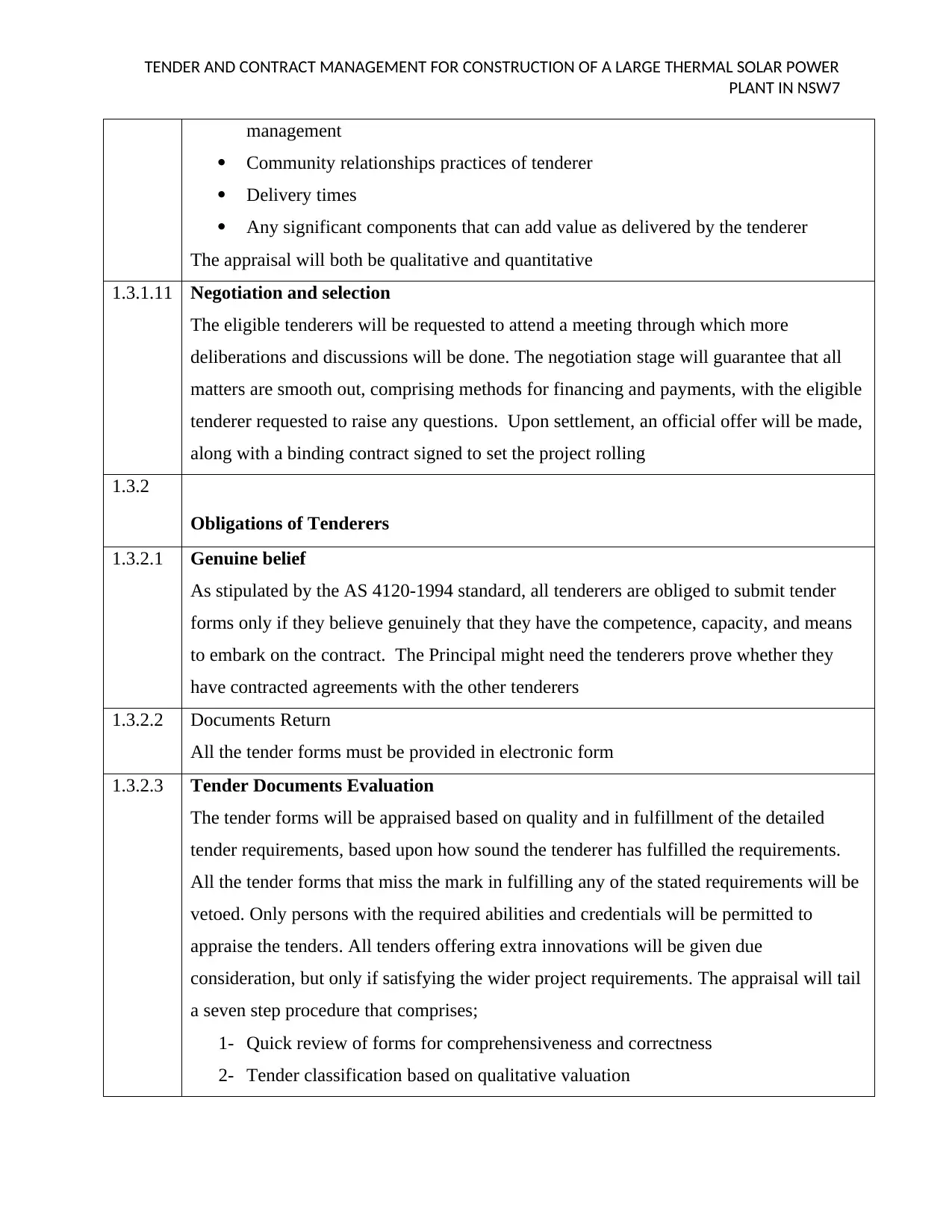
TENDER AND CONTRACT MANAGEMENT FOR CONSTRUCTION OF A LARGE THERMAL SOLAR POWER
PLANT IN NSW7
management
Community relationships practices of tenderer
Delivery times
Any significant components that can add value as delivered by the tenderer
The appraisal will both be qualitative and quantitative
1.3.1.11 Negotiation and selection
The eligible tenderers will be requested to attend a meeting through which more
deliberations and discussions will be done. The negotiation stage will guarantee that all
matters are smooth out, comprising methods for financing and payments, with the eligible
tenderer requested to raise any questions. Upon settlement, an official offer will be made,
along with a binding contract signed to set the project rolling
1.3.2
Obligations of Tenderers
1.3.2.1 Genuine belief
As stipulated by the AS 4120-1994 standard, all tenderers are obliged to submit tender
forms only if they believe genuinely that they have the competence, capacity, and means
to embark on the contract. The Principal might need the tenderers prove whether they
have contracted agreements with the other tenderers
1.3.2.2 Documents Return
All the tender forms must be provided in electronic form
1.3.2.3 Tender Documents Evaluation
The tender forms will be appraised based on quality and in fulfillment of the detailed
tender requirements, based upon how sound the tenderer has fulfilled the requirements.
All the tender forms that miss the mark in fulfilling any of the stated requirements will be
vetoed. Only persons with the required abilities and credentials will be permitted to
appraise the tenders. All tenders offering extra innovations will be given due
consideration, but only if satisfying the wider project requirements. The appraisal will tail
a seven step procedure that comprises;
1- Quick review of forms for comprehensiveness and correctness
2- Tender classification based on qualitative valuation
PLANT IN NSW7
management
Community relationships practices of tenderer
Delivery times
Any significant components that can add value as delivered by the tenderer
The appraisal will both be qualitative and quantitative
1.3.1.11 Negotiation and selection
The eligible tenderers will be requested to attend a meeting through which more
deliberations and discussions will be done. The negotiation stage will guarantee that all
matters are smooth out, comprising methods for financing and payments, with the eligible
tenderer requested to raise any questions. Upon settlement, an official offer will be made,
along with a binding contract signed to set the project rolling
1.3.2
Obligations of Tenderers
1.3.2.1 Genuine belief
As stipulated by the AS 4120-1994 standard, all tenderers are obliged to submit tender
forms only if they believe genuinely that they have the competence, capacity, and means
to embark on the contract. The Principal might need the tenderers prove whether they
have contracted agreements with the other tenderers
1.3.2.2 Documents Return
All the tender forms must be provided in electronic form
1.3.2.3 Tender Documents Evaluation
The tender forms will be appraised based on quality and in fulfillment of the detailed
tender requirements, based upon how sound the tenderer has fulfilled the requirements.
All the tender forms that miss the mark in fulfilling any of the stated requirements will be
vetoed. Only persons with the required abilities and credentials will be permitted to
appraise the tenders. All tenders offering extra innovations will be given due
consideration, but only if satisfying the wider project requirements. The appraisal will tail
a seven step procedure that comprises;
1- Quick review of forms for comprehensiveness and correctness
2- Tender classification based on qualitative valuation
Paraphrase This Document
Need a fresh take? Get an instant paraphrase of this document with our AI Paraphraser
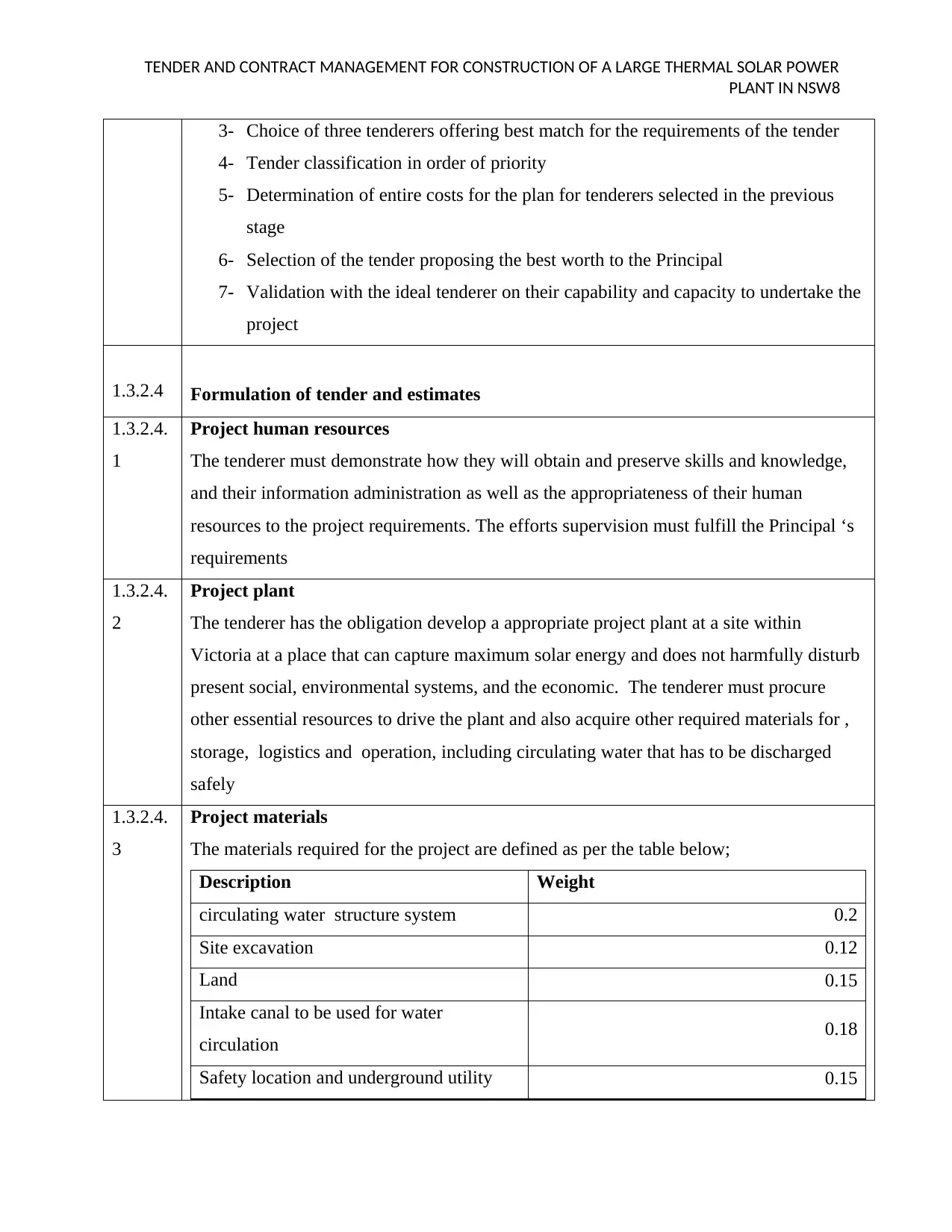
TENDER AND CONTRACT MANAGEMENT FOR CONSTRUCTION OF A LARGE THERMAL SOLAR POWER
PLANT IN NSW8
3- Choice of three tenderers offering best match for the requirements of the tender
4- Tender classification in order of priority
5- Determination of entire costs for the plan for tenderers selected in the previous
stage
6- Selection of the tender proposing the best worth to the Principal
7- Validation with the ideal tenderer on their capability and capacity to undertake the
project
1.3.2.4 Formulation of tender and estimates
1.3.2.4.
1
Project human resources
The tenderer must demonstrate how they will obtain and preserve skills and knowledge,
and their information administration as well as the appropriateness of their human
resources to the project requirements. The efforts supervision must fulfill the Principal ‘s
requirements
1.3.2.4.
2
Project plant
The tenderer has the obligation develop a appropriate project plant at a site within
Victoria at a place that can capture maximum solar energy and does not harmfully disturb
present social, environmental systems, and the economic. The tenderer must procure
other essential resources to drive the plant and also acquire other required materials for ,
storage, logistics and operation, including circulating water that has to be discharged
safely
1.3.2.4.
3
Project materials
The materials required for the project are defined as per the table below;
Description Weight
circulating water structure system 0.2
Site excavation 0.12
Land 0.15
Intake canal to be used for water
circulation 0.18
Safety location and underground utility 0.15
PLANT IN NSW8
3- Choice of three tenderers offering best match for the requirements of the tender
4- Tender classification in order of priority
5- Determination of entire costs for the plan for tenderers selected in the previous
stage
6- Selection of the tender proposing the best worth to the Principal
7- Validation with the ideal tenderer on their capability and capacity to undertake the
project
1.3.2.4 Formulation of tender and estimates
1.3.2.4.
1
Project human resources
The tenderer must demonstrate how they will obtain and preserve skills and knowledge,
and their information administration as well as the appropriateness of their human
resources to the project requirements. The efforts supervision must fulfill the Principal ‘s
requirements
1.3.2.4.
2
Project plant
The tenderer has the obligation develop a appropriate project plant at a site within
Victoria at a place that can capture maximum solar energy and does not harmfully disturb
present social, environmental systems, and the economic. The tenderer must procure
other essential resources to drive the plant and also acquire other required materials for ,
storage, logistics and operation, including circulating water that has to be discharged
safely
1.3.2.4.
3
Project materials
The materials required for the project are defined as per the table below;
Description Weight
circulating water structure system 0.2
Site excavation 0.12
Land 0.15
Intake canal to be used for water
circulation 0.18
Safety location and underground utility 0.15
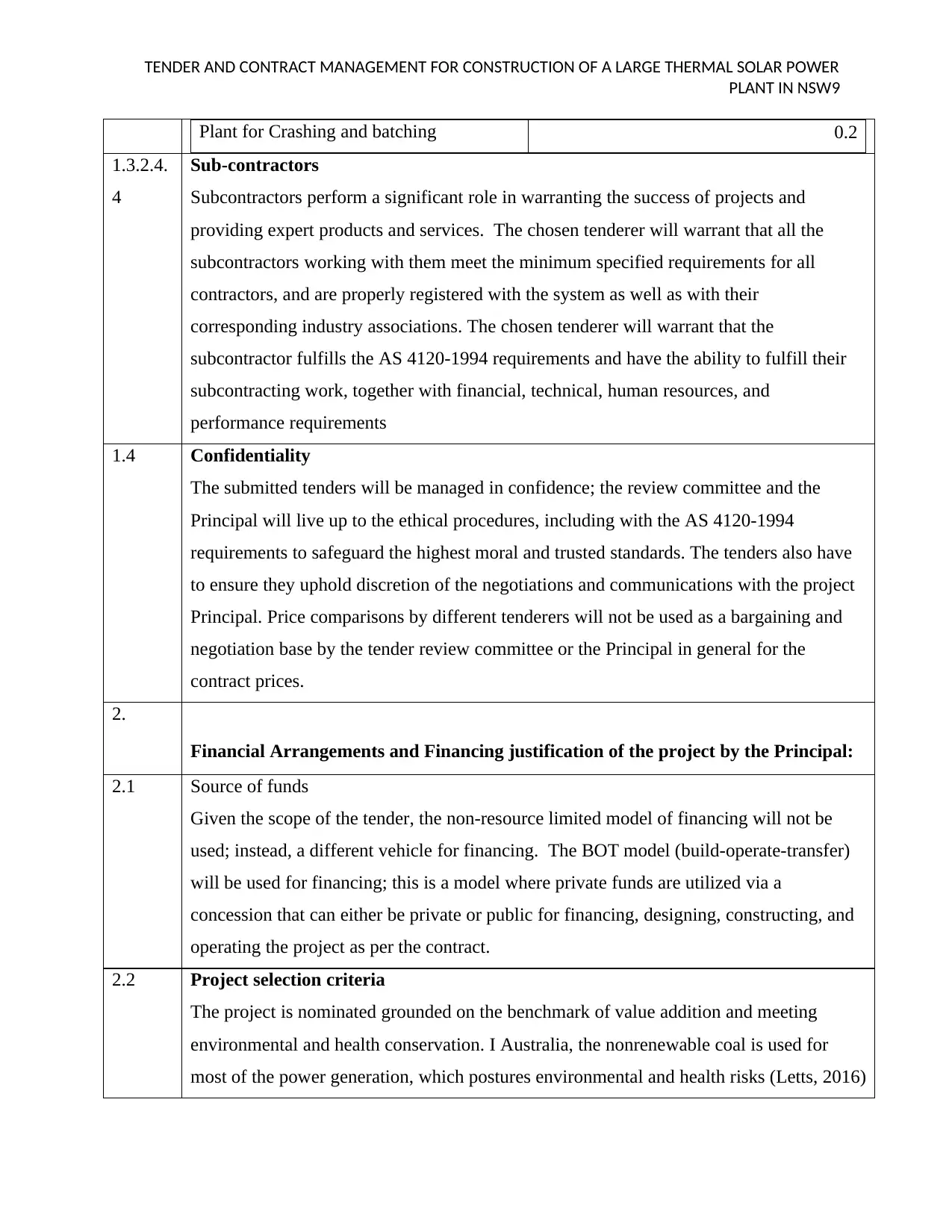
TENDER AND CONTRACT MANAGEMENT FOR CONSTRUCTION OF A LARGE THERMAL SOLAR POWER
PLANT IN NSW9
Plant for Crashing and batching 0.2
1.3.2.4.
4
Sub-contractors
Subcontractors perform a significant role in warranting the success of projects and
providing expert products and services. The chosen tenderer will warrant that all the
subcontractors working with them meet the minimum specified requirements for all
contractors, and are properly registered with the system as well as with their
corresponding industry associations. The chosen tenderer will warrant that the
subcontractor fulfills the AS 4120-1994 requirements and have the ability to fulfill their
subcontracting work, together with financial, technical, human resources, and
performance requirements
1.4 Confidentiality
The submitted tenders will be managed in confidence; the review committee and the
Principal will live up to the ethical procedures, including with the AS 4120-1994
requirements to safeguard the highest moral and trusted standards. The tenders also have
to ensure they uphold discretion of the negotiations and communications with the project
Principal. Price comparisons by different tenderers will not be used as a bargaining and
negotiation base by the tender review committee or the Principal in general for the
contract prices.
2.
Financial Arrangements and Financing justification of the project by the Principal:
2.1 Source of funds
Given the scope of the tender, the non-resource limited model of financing will not be
used; instead, a different vehicle for financing. The BOT model (build-operate-transfer)
will be used for financing; this is a model where private funds are utilized via a
concession that can either be private or public for financing, designing, constructing, and
operating the project as per the contract.
2.2 Project selection criteria
The project is nominated grounded on the benchmark of value addition and meeting
environmental and health conservation. I Australia, the nonrenewable coal is used for
most of the power generation, which postures environmental and health risks (Letts, 2016)
PLANT IN NSW9
Plant for Crashing and batching 0.2
1.3.2.4.
4
Sub-contractors
Subcontractors perform a significant role in warranting the success of projects and
providing expert products and services. The chosen tenderer will warrant that all the
subcontractors working with them meet the minimum specified requirements for all
contractors, and are properly registered with the system as well as with their
corresponding industry associations. The chosen tenderer will warrant that the
subcontractor fulfills the AS 4120-1994 requirements and have the ability to fulfill their
subcontracting work, together with financial, technical, human resources, and
performance requirements
1.4 Confidentiality
The submitted tenders will be managed in confidence; the review committee and the
Principal will live up to the ethical procedures, including with the AS 4120-1994
requirements to safeguard the highest moral and trusted standards. The tenders also have
to ensure they uphold discretion of the negotiations and communications with the project
Principal. Price comparisons by different tenderers will not be used as a bargaining and
negotiation base by the tender review committee or the Principal in general for the
contract prices.
2.
Financial Arrangements and Financing justification of the project by the Principal:
2.1 Source of funds
Given the scope of the tender, the non-resource limited model of financing will not be
used; instead, a different vehicle for financing. The BOT model (build-operate-transfer)
will be used for financing; this is a model where private funds are utilized via a
concession that can either be private or public for financing, designing, constructing, and
operating the project as per the contract.
2.2 Project selection criteria
The project is nominated grounded on the benchmark of value addition and meeting
environmental and health conservation. I Australia, the nonrenewable coal is used for
most of the power generation, which postures environmental and health risks (Letts, 2016)
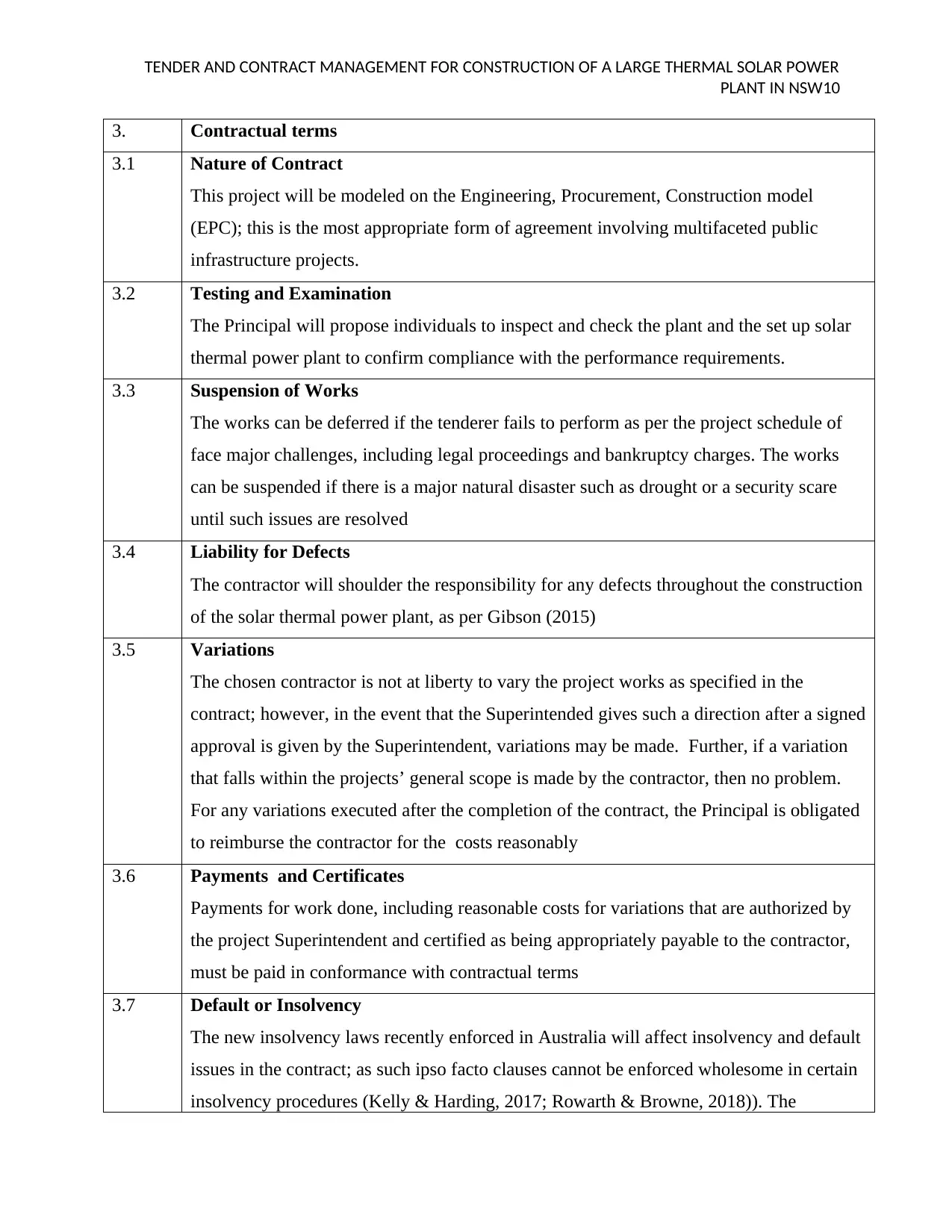
TENDER AND CONTRACT MANAGEMENT FOR CONSTRUCTION OF A LARGE THERMAL SOLAR POWER
PLANT IN NSW10
3. Contractual terms
3.1 Nature of Contract
This project will be modeled on the Engineering, Procurement, Construction model
(EPC); this is the most appropriate form of agreement involving multifaceted public
infrastructure projects.
3.2 Testing and Examination
The Principal will propose individuals to inspect and check the plant and the set up solar
thermal power plant to confirm compliance with the performance requirements.
3.3 Suspension of Works
The works can be deferred if the tenderer fails to perform as per the project schedule of
face major challenges, including legal proceedings and bankruptcy charges. The works
can be suspended if there is a major natural disaster such as drought or a security scare
until such issues are resolved
3.4 Liability for Defects
The contractor will shoulder the responsibility for any defects throughout the construction
of the solar thermal power plant, as per Gibson (2015)
3.5 Variations
The chosen contractor is not at liberty to vary the project works as specified in the
contract; however, in the event that the Superintended gives such a direction after a signed
approval is given by the Superintendent, variations may be made. Further, if a variation
that falls within the projects’ general scope is made by the contractor, then no problem.
For any variations executed after the completion of the contract, the Principal is obligated
to reimburse the contractor for the costs reasonably
3.6 Payments and Certificates
Payments for work done, including reasonable costs for variations that are authorized by
the project Superintendent and certified as being appropriately payable to the contractor,
must be paid in conformance with contractual terms
3.7 Default or Insolvency
The new insolvency laws recently enforced in Australia will affect insolvency and default
issues in the contract; as such ipso facto clauses cannot be enforced wholesome in certain
insolvency procedures (Kelly & Harding, 2017; Rowarth & Browne, 2018)). The
PLANT IN NSW10
3. Contractual terms
3.1 Nature of Contract
This project will be modeled on the Engineering, Procurement, Construction model
(EPC); this is the most appropriate form of agreement involving multifaceted public
infrastructure projects.
3.2 Testing and Examination
The Principal will propose individuals to inspect and check the plant and the set up solar
thermal power plant to confirm compliance with the performance requirements.
3.3 Suspension of Works
The works can be deferred if the tenderer fails to perform as per the project schedule of
face major challenges, including legal proceedings and bankruptcy charges. The works
can be suspended if there is a major natural disaster such as drought or a security scare
until such issues are resolved
3.4 Liability for Defects
The contractor will shoulder the responsibility for any defects throughout the construction
of the solar thermal power plant, as per Gibson (2015)
3.5 Variations
The chosen contractor is not at liberty to vary the project works as specified in the
contract; however, in the event that the Superintended gives such a direction after a signed
approval is given by the Superintendent, variations may be made. Further, if a variation
that falls within the projects’ general scope is made by the contractor, then no problem.
For any variations executed after the completion of the contract, the Principal is obligated
to reimburse the contractor for the costs reasonably
3.6 Payments and Certificates
Payments for work done, including reasonable costs for variations that are authorized by
the project Superintendent and certified as being appropriately payable to the contractor,
must be paid in conformance with contractual terms
3.7 Default or Insolvency
The new insolvency laws recently enforced in Australia will affect insolvency and default
issues in the contract; as such ipso facto clauses cannot be enforced wholesome in certain
insolvency procedures (Kelly & Harding, 2017; Rowarth & Browne, 2018)). The
Secure Best Marks with AI Grader
Need help grading? Try our AI Grader for instant feedback on your assignments.
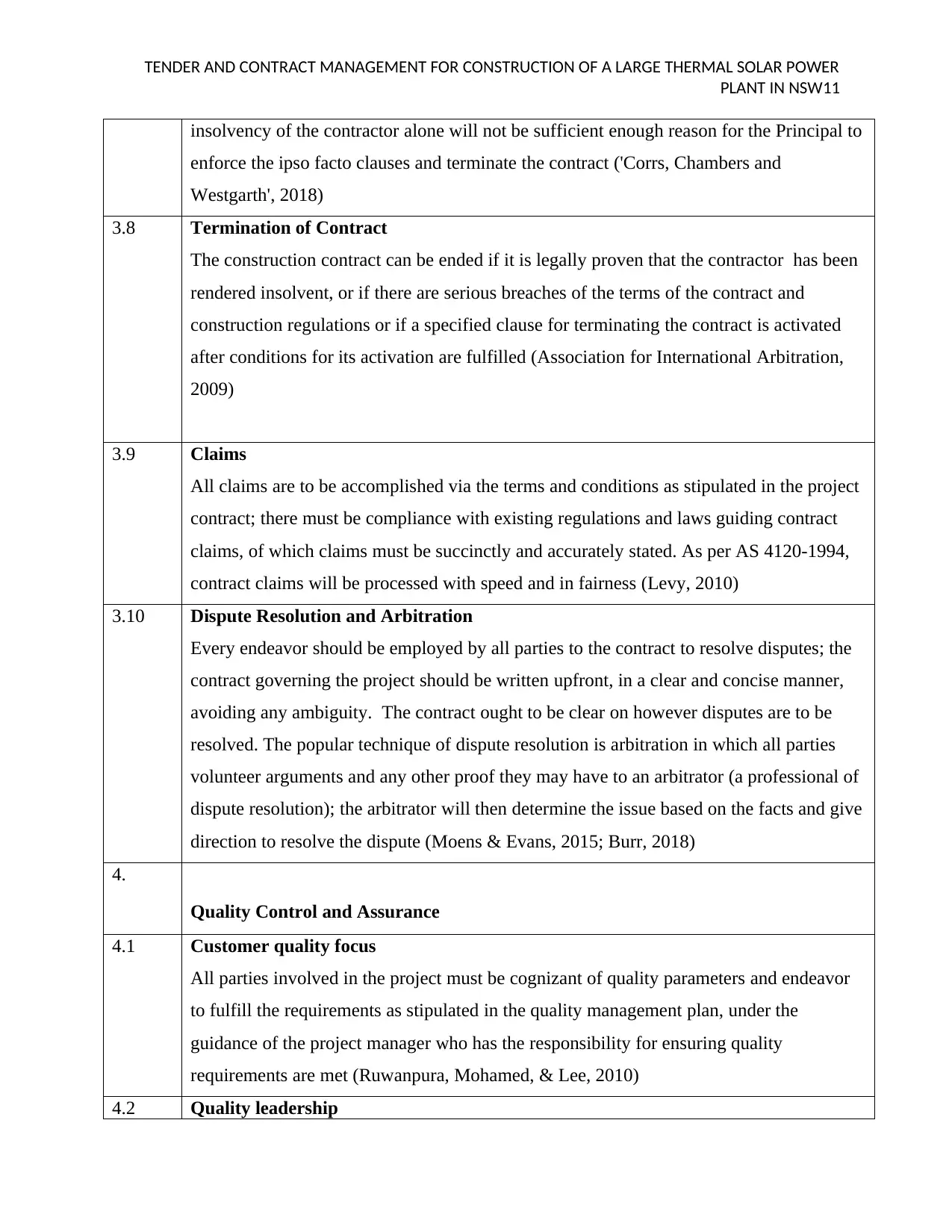
TENDER AND CONTRACT MANAGEMENT FOR CONSTRUCTION OF A LARGE THERMAL SOLAR POWER
PLANT IN NSW11
insolvency of the contractor alone will not be sufficient enough reason for the Principal to
enforce the ipso facto clauses and terminate the contract ('Corrs, Chambers and
Westgarth', 2018)
3.8 Termination of Contract
The construction contract can be ended if it is legally proven that the contractor has been
rendered insolvent, or if there are serious breaches of the terms of the contract and
construction regulations or if a specified clause for terminating the contract is activated
after conditions for its activation are fulfilled (Association for International Arbitration,
2009)
3.9 Claims
All claims are to be accomplished via the terms and conditions as stipulated in the project
contract; there must be compliance with existing regulations and laws guiding contract
claims, of which claims must be succinctly and accurately stated. As per AS 4120-1994,
contract claims will be processed with speed and in fairness (Levy, 2010)
3.10 Dispute Resolution and Arbitration
Every endeavor should be employed by all parties to the contract to resolve disputes; the
contract governing the project should be written upfront, in a clear and concise manner,
avoiding any ambiguity. The contract ought to be clear on however disputes are to be
resolved. The popular technique of dispute resolution is arbitration in which all parties
volunteer arguments and any other proof they may have to an arbitrator (a professional of
dispute resolution); the arbitrator will then determine the issue based on the facts and give
direction to resolve the dispute (Moens & Evans, 2015; Burr, 2018)
4.
Quality Control and Assurance
4.1 Customer quality focus
All parties involved in the project must be cognizant of quality parameters and endeavor
to fulfill the requirements as stipulated in the quality management plan, under the
guidance of the project manager who has the responsibility for ensuring quality
requirements are met (Ruwanpura, Mohamed, & Lee, 2010)
4.2 Quality leadership
PLANT IN NSW11
insolvency of the contractor alone will not be sufficient enough reason for the Principal to
enforce the ipso facto clauses and terminate the contract ('Corrs, Chambers and
Westgarth', 2018)
3.8 Termination of Contract
The construction contract can be ended if it is legally proven that the contractor has been
rendered insolvent, or if there are serious breaches of the terms of the contract and
construction regulations or if a specified clause for terminating the contract is activated
after conditions for its activation are fulfilled (Association for International Arbitration,
2009)
3.9 Claims
All claims are to be accomplished via the terms and conditions as stipulated in the project
contract; there must be compliance with existing regulations and laws guiding contract
claims, of which claims must be succinctly and accurately stated. As per AS 4120-1994,
contract claims will be processed with speed and in fairness (Levy, 2010)
3.10 Dispute Resolution and Arbitration
Every endeavor should be employed by all parties to the contract to resolve disputes; the
contract governing the project should be written upfront, in a clear and concise manner,
avoiding any ambiguity. The contract ought to be clear on however disputes are to be
resolved. The popular technique of dispute resolution is arbitration in which all parties
volunteer arguments and any other proof they may have to an arbitrator (a professional of
dispute resolution); the arbitrator will then determine the issue based on the facts and give
direction to resolve the dispute (Moens & Evans, 2015; Burr, 2018)
4.
Quality Control and Assurance
4.1 Customer quality focus
All parties involved in the project must be cognizant of quality parameters and endeavor
to fulfill the requirements as stipulated in the quality management plan, under the
guidance of the project manager who has the responsibility for ensuring quality
requirements are met (Ruwanpura, Mohamed, & Lee, 2010)
4.2 Quality leadership
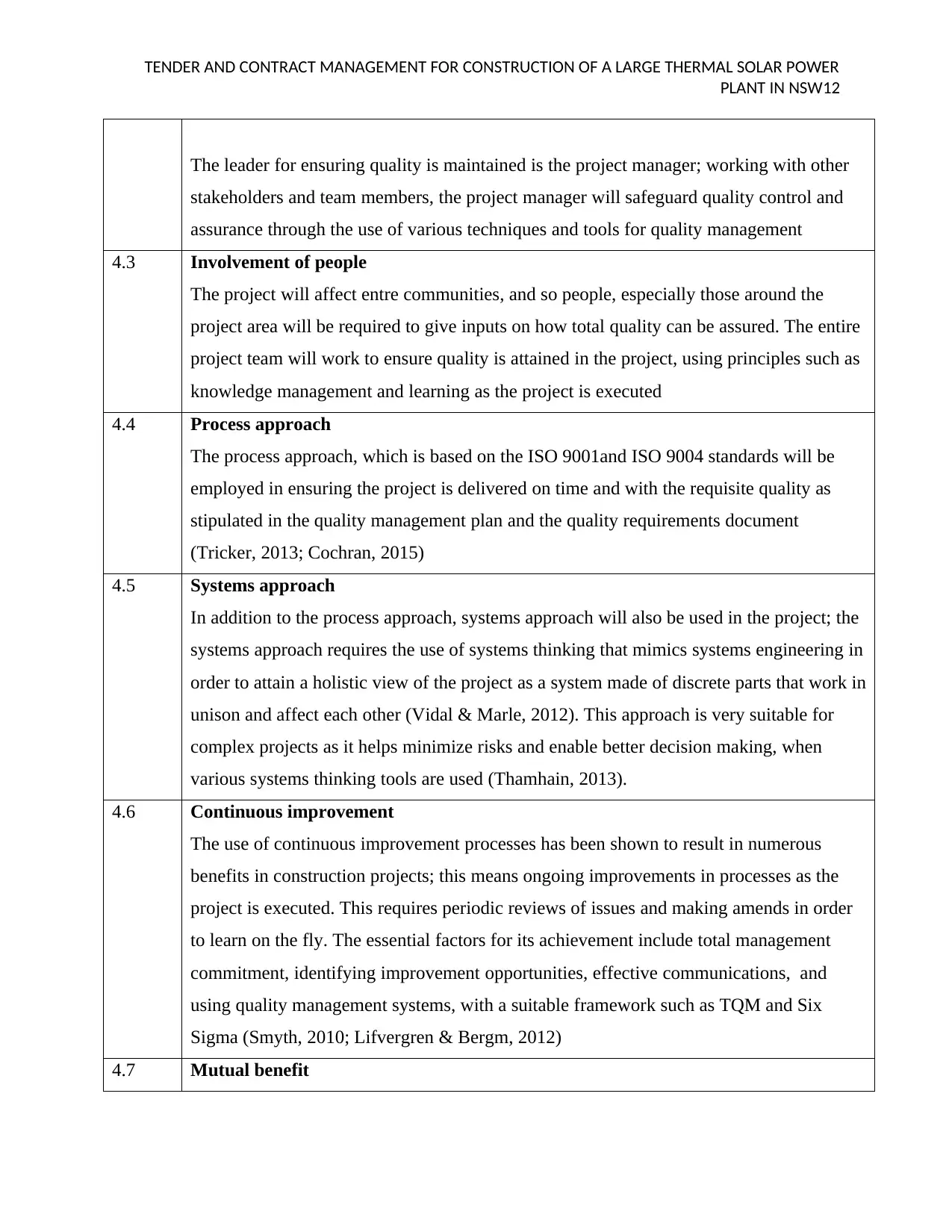
TENDER AND CONTRACT MANAGEMENT FOR CONSTRUCTION OF A LARGE THERMAL SOLAR POWER
PLANT IN NSW12
The leader for ensuring quality is maintained is the project manager; working with other
stakeholders and team members, the project manager will safeguard quality control and
assurance through the use of various techniques and tools for quality management
4.3 Involvement of people
The project will affect entre communities, and so people, especially those around the
project area will be required to give inputs on how total quality can be assured. The entire
project team will work to ensure quality is attained in the project, using principles such as
knowledge management and learning as the project is executed
4.4 Process approach
The process approach, which is based on the ISO 9001and ISO 9004 standards will be
employed in ensuring the project is delivered on time and with the requisite quality as
stipulated in the quality management plan and the quality requirements document
(Tricker, 2013; Cochran, 2015)
4.5 Systems approach
In addition to the process approach, systems approach will also be used in the project; the
systems approach requires the use of systems thinking that mimics systems engineering in
order to attain a holistic view of the project as a system made of discrete parts that work in
unison and affect each other (Vidal & Marle, 2012). This approach is very suitable for
complex projects as it helps minimize risks and enable better decision making, when
various systems thinking tools are used (Thamhain, 2013).
4.6 Continuous improvement
The use of continuous improvement processes has been shown to result in numerous
benefits in construction projects; this means ongoing improvements in processes as the
project is executed. This requires periodic reviews of issues and making amends in order
to learn on the fly. The essential factors for its achievement include total management
commitment, identifying improvement opportunities, effective communications, and
using quality management systems, with a suitable framework such as TQM and Six
Sigma (Smyth, 2010; Lifvergren & Bergm, 2012)
4.7 Mutual benefit
PLANT IN NSW12
The leader for ensuring quality is maintained is the project manager; working with other
stakeholders and team members, the project manager will safeguard quality control and
assurance through the use of various techniques and tools for quality management
4.3 Involvement of people
The project will affect entre communities, and so people, especially those around the
project area will be required to give inputs on how total quality can be assured. The entire
project team will work to ensure quality is attained in the project, using principles such as
knowledge management and learning as the project is executed
4.4 Process approach
The process approach, which is based on the ISO 9001and ISO 9004 standards will be
employed in ensuring the project is delivered on time and with the requisite quality as
stipulated in the quality management plan and the quality requirements document
(Tricker, 2013; Cochran, 2015)
4.5 Systems approach
In addition to the process approach, systems approach will also be used in the project; the
systems approach requires the use of systems thinking that mimics systems engineering in
order to attain a holistic view of the project as a system made of discrete parts that work in
unison and affect each other (Vidal & Marle, 2012). This approach is very suitable for
complex projects as it helps minimize risks and enable better decision making, when
various systems thinking tools are used (Thamhain, 2013).
4.6 Continuous improvement
The use of continuous improvement processes has been shown to result in numerous
benefits in construction projects; this means ongoing improvements in processes as the
project is executed. This requires periodic reviews of issues and making amends in order
to learn on the fly. The essential factors for its achievement include total management
commitment, identifying improvement opportunities, effective communications, and
using quality management systems, with a suitable framework such as TQM and Six
Sigma (Smyth, 2010; Lifvergren & Bergm, 2012)
4.7 Mutual benefit
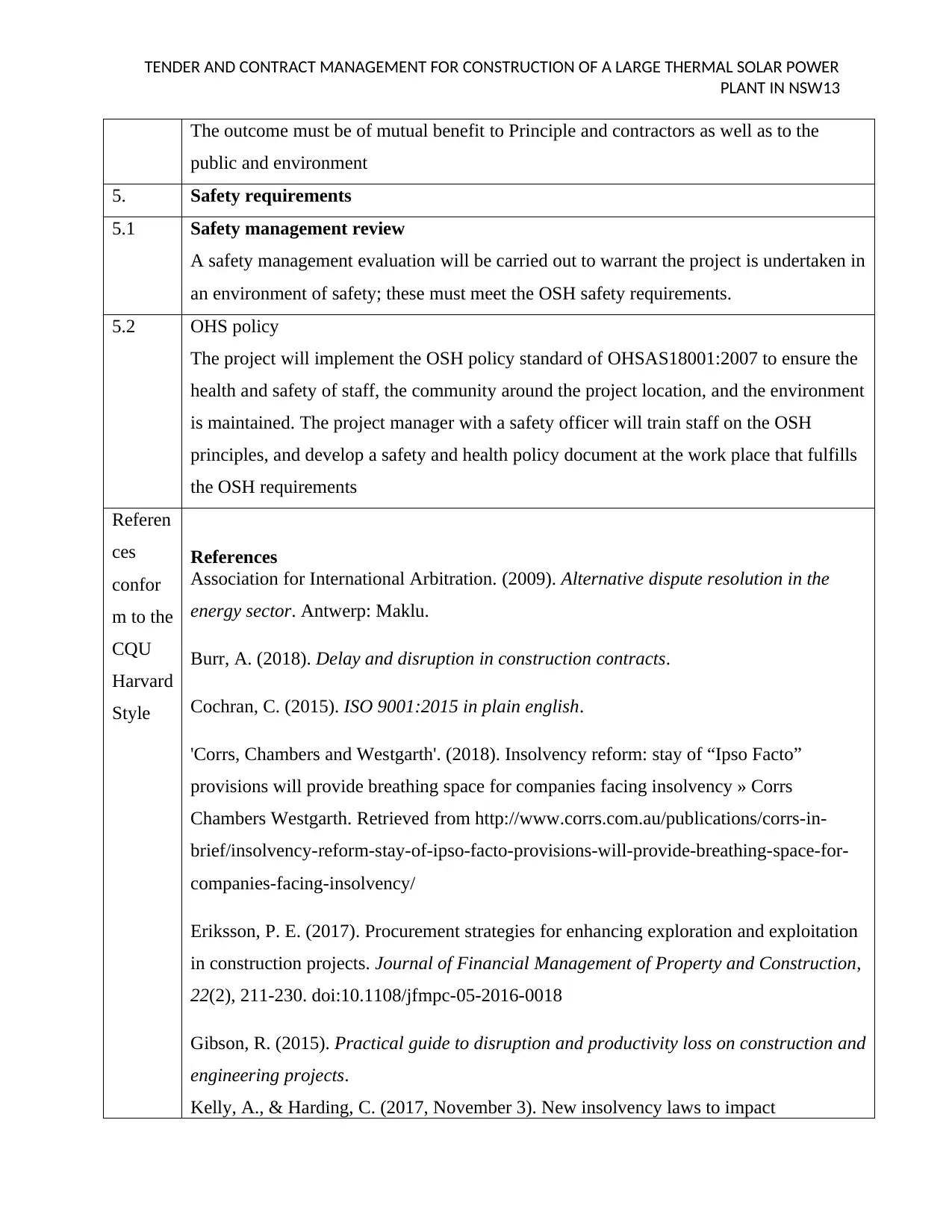
TENDER AND CONTRACT MANAGEMENT FOR CONSTRUCTION OF A LARGE THERMAL SOLAR POWER
PLANT IN NSW13
The outcome must be of mutual benefit to Principle and contractors as well as to the
public and environment
5. Safety requirements
5.1 Safety management review
A safety management evaluation will be carried out to warrant the project is undertaken in
an environment of safety; these must meet the OSH safety requirements.
5.2 OHS policy
The project will implement the OSH policy standard of OHSAS18001:2007 to ensure the
health and safety of staff, the community around the project location, and the environment
is maintained. The project manager with a safety officer will train staff on the OSH
principles, and develop a safety and health policy document at the work place that fulfills
the OSH requirements
Referen
ces
confor
m to the
CQU
Harvard
Style
References
Association for International Arbitration. (2009). Alternative dispute resolution in the
energy sector. Antwerp: Maklu.
Burr, A. (2018). Delay and disruption in construction contracts.
Cochran, C. (2015). ISO 9001:2015 in plain english.
'Corrs, Chambers and Westgarth'. (2018). Insolvency reform: stay of “Ipso Facto”
provisions will provide breathing space for companies facing insolvency » Corrs
Chambers Westgarth. Retrieved from http://www.corrs.com.au/publications/corrs-in-
brief/insolvency-reform-stay-of-ipso-facto-provisions-will-provide-breathing-space-for-
companies-facing-insolvency/
Eriksson, P. E. (2017). Procurement strategies for enhancing exploration and exploitation
in construction projects. Journal of Financial Management of Property and Construction,
22(2), 211-230. doi:10.1108/jfmpc-05-2016-0018
Gibson, R. (2015). Practical guide to disruption and productivity loss on construction and
engineering projects.
Kelly, A., & Harding, C. (2017, November 3). New insolvency laws to impact
PLANT IN NSW13
The outcome must be of mutual benefit to Principle and contractors as well as to the
public and environment
5. Safety requirements
5.1 Safety management review
A safety management evaluation will be carried out to warrant the project is undertaken in
an environment of safety; these must meet the OSH safety requirements.
5.2 OHS policy
The project will implement the OSH policy standard of OHSAS18001:2007 to ensure the
health and safety of staff, the community around the project location, and the environment
is maintained. The project manager with a safety officer will train staff on the OSH
principles, and develop a safety and health policy document at the work place that fulfills
the OSH requirements
Referen
ces
confor
m to the
CQU
Harvard
Style
References
Association for International Arbitration. (2009). Alternative dispute resolution in the
energy sector. Antwerp: Maklu.
Burr, A. (2018). Delay and disruption in construction contracts.
Cochran, C. (2015). ISO 9001:2015 in plain english.
'Corrs, Chambers and Westgarth'. (2018). Insolvency reform: stay of “Ipso Facto”
provisions will provide breathing space for companies facing insolvency » Corrs
Chambers Westgarth. Retrieved from http://www.corrs.com.au/publications/corrs-in-
brief/insolvency-reform-stay-of-ipso-facto-provisions-will-provide-breathing-space-for-
companies-facing-insolvency/
Eriksson, P. E. (2017). Procurement strategies for enhancing exploration and exploitation
in construction projects. Journal of Financial Management of Property and Construction,
22(2), 211-230. doi:10.1108/jfmpc-05-2016-0018
Gibson, R. (2015). Practical guide to disruption and productivity loss on construction and
engineering projects.
Kelly, A., & Harding, C. (2017, November 3). New insolvency laws to impact
Paraphrase This Document
Need a fresh take? Get an instant paraphrase of this document with our AI Paraphraser
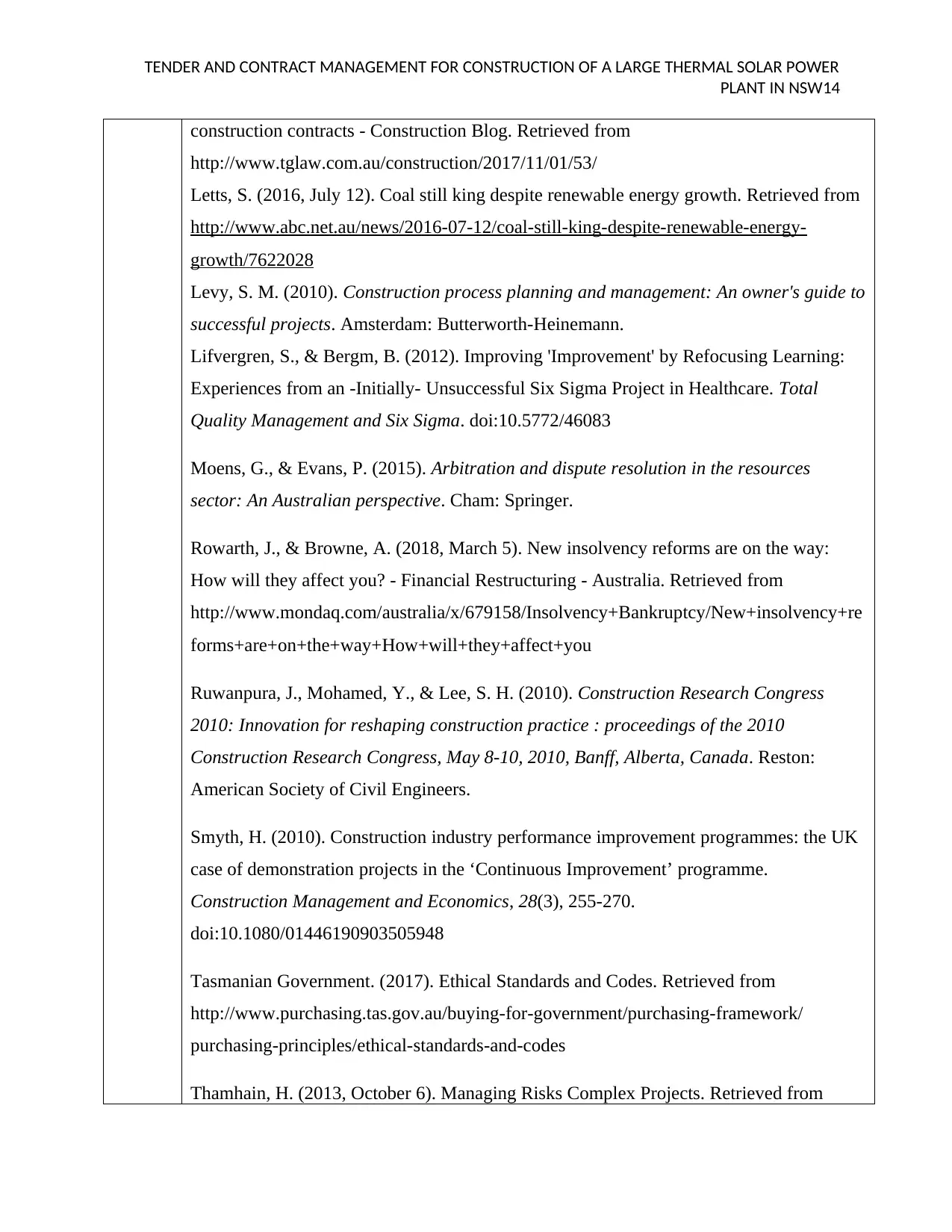
TENDER AND CONTRACT MANAGEMENT FOR CONSTRUCTION OF A LARGE THERMAL SOLAR POWER
PLANT IN NSW14
construction contracts - Construction Blog. Retrieved from
http://www.tglaw.com.au/construction/2017/11/01/53/
Letts, S. (2016, July 12). Coal still king despite renewable energy growth. Retrieved from
http://www.abc.net.au/news/2016-07-12/coal-still-king-despite-renewable-energy-
growth/7622028
Levy, S. M. (2010). Construction process planning and management: An owner's guide to
successful projects. Amsterdam: Butterworth-Heinemann.
Lifvergren, S., & Bergm, B. (2012). Improving 'Improvement' by Refocusing Learning:
Experiences from an -Initially- Unsuccessful Six Sigma Project in Healthcare. Total
Quality Management and Six Sigma. doi:10.5772/46083
Moens, G., & Evans, P. (2015). Arbitration and dispute resolution in the resources
sector: An Australian perspective. Cham: Springer.
Rowarth, J., & Browne, A. (2018, March 5). New insolvency reforms are on the way:
How will they affect you? - Financial Restructuring - Australia. Retrieved from
http://www.mondaq.com/australia/x/679158/Insolvency+Bankruptcy/New+insolvency+re
forms+are+on+the+way+How+will+they+affect+you
Ruwanpura, J., Mohamed, Y., & Lee, S. H. (2010). Construction Research Congress
2010: Innovation for reshaping construction practice : proceedings of the 2010
Construction Research Congress, May 8-10, 2010, Banff, Alberta, Canada. Reston:
American Society of Civil Engineers.
Smyth, H. (2010). Construction industry performance improvement programmes: the UK
case of demonstration projects in the ‘Continuous Improvement’ programme.
Construction Management and Economics, 28(3), 255-270.
doi:10.1080/01446190903505948
Tasmanian Government. (2017). Ethical Standards and Codes. Retrieved from
http://www.purchasing.tas.gov.au/buying-for-government/purchasing-framework/
purchasing-principles/ethical-standards-and-codes
Thamhain, H. (2013, October 6). Managing Risks Complex Projects. Retrieved from
PLANT IN NSW14
construction contracts - Construction Blog. Retrieved from
http://www.tglaw.com.au/construction/2017/11/01/53/
Letts, S. (2016, July 12). Coal still king despite renewable energy growth. Retrieved from
http://www.abc.net.au/news/2016-07-12/coal-still-king-despite-renewable-energy-
growth/7622028
Levy, S. M. (2010). Construction process planning and management: An owner's guide to
successful projects. Amsterdam: Butterworth-Heinemann.
Lifvergren, S., & Bergm, B. (2012). Improving 'Improvement' by Refocusing Learning:
Experiences from an -Initially- Unsuccessful Six Sigma Project in Healthcare. Total
Quality Management and Six Sigma. doi:10.5772/46083
Moens, G., & Evans, P. (2015). Arbitration and dispute resolution in the resources
sector: An Australian perspective. Cham: Springer.
Rowarth, J., & Browne, A. (2018, March 5). New insolvency reforms are on the way:
How will they affect you? - Financial Restructuring - Australia. Retrieved from
http://www.mondaq.com/australia/x/679158/Insolvency+Bankruptcy/New+insolvency+re
forms+are+on+the+way+How+will+they+affect+you
Ruwanpura, J., Mohamed, Y., & Lee, S. H. (2010). Construction Research Congress
2010: Innovation for reshaping construction practice : proceedings of the 2010
Construction Research Congress, May 8-10, 2010, Banff, Alberta, Canada. Reston:
American Society of Civil Engineers.
Smyth, H. (2010). Construction industry performance improvement programmes: the UK
case of demonstration projects in the ‘Continuous Improvement’ programme.
Construction Management and Economics, 28(3), 255-270.
doi:10.1080/01446190903505948
Tasmanian Government. (2017). Ethical Standards and Codes. Retrieved from
http://www.purchasing.tas.gov.au/buying-for-government/purchasing-framework/
purchasing-principles/ethical-standards-and-codes
Thamhain, H. (2013, October 6). Managing Risks Complex Projects. Retrieved from
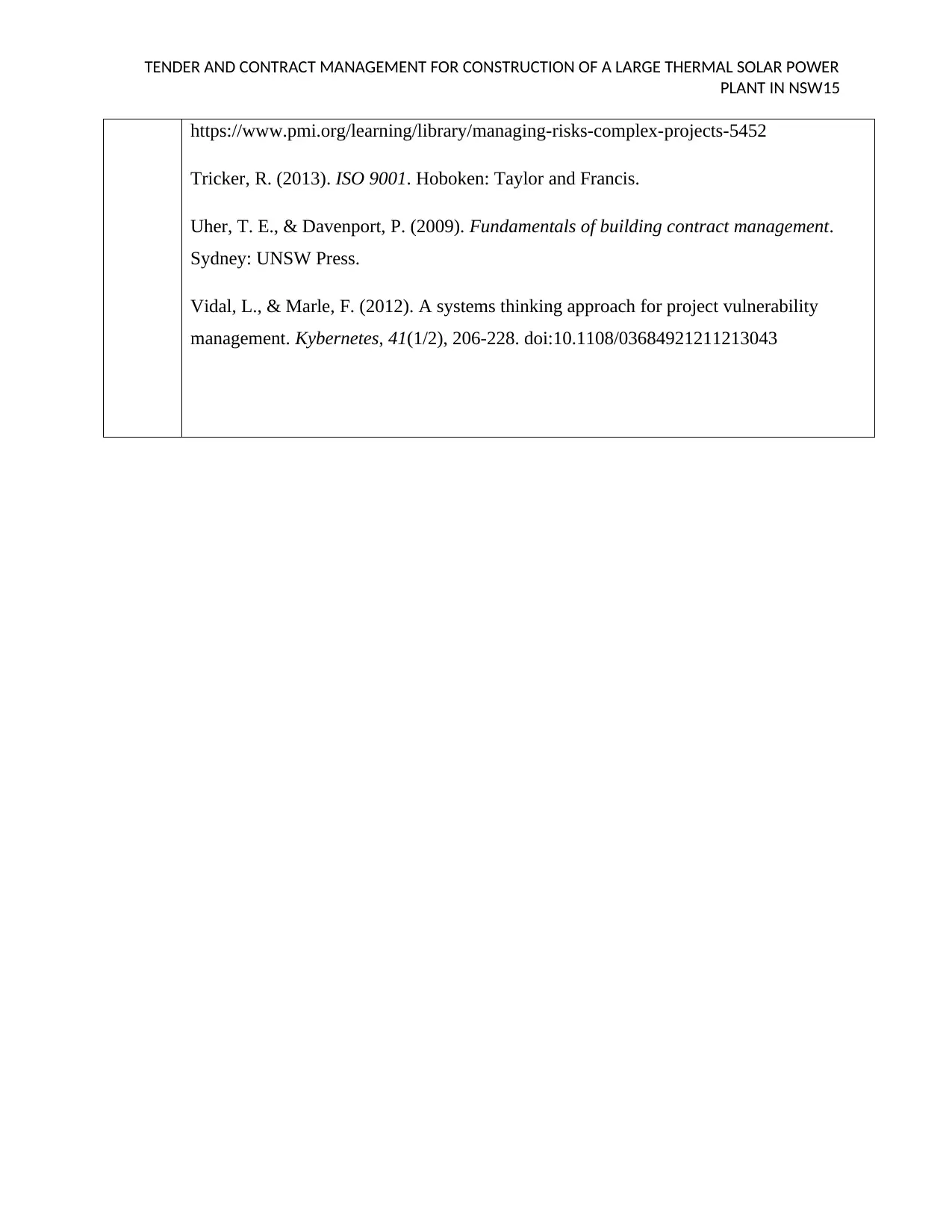
TENDER AND CONTRACT MANAGEMENT FOR CONSTRUCTION OF A LARGE THERMAL SOLAR POWER
PLANT IN NSW15
https://www.pmi.org/learning/library/managing-risks-complex-projects-5452
Tricker, R. (2013). ISO 9001. Hoboken: Taylor and Francis.
Uher, T. E., & Davenport, P. (2009). Fundamentals of building contract management.
Sydney: UNSW Press.
Vidal, L., & Marle, F. (2012). A systems thinking approach for project vulnerability
management. Kybernetes, 41(1/2), 206-228. doi:10.1108/03684921211213043
PLANT IN NSW15
https://www.pmi.org/learning/library/managing-risks-complex-projects-5452
Tricker, R. (2013). ISO 9001. Hoboken: Taylor and Francis.
Uher, T. E., & Davenport, P. (2009). Fundamentals of building contract management.
Sydney: UNSW Press.
Vidal, L., & Marle, F. (2012). A systems thinking approach for project vulnerability
management. Kybernetes, 41(1/2), 206-228. doi:10.1108/03684921211213043
1 out of 15
Related Documents
Your All-in-One AI-Powered Toolkit for Academic Success.
+13062052269
info@desklib.com
Available 24*7 on WhatsApp / Email
![[object Object]](/_next/static/media/star-bottom.7253800d.svg)
Unlock your academic potential
© 2024 | Zucol Services PVT LTD | All rights reserved.




